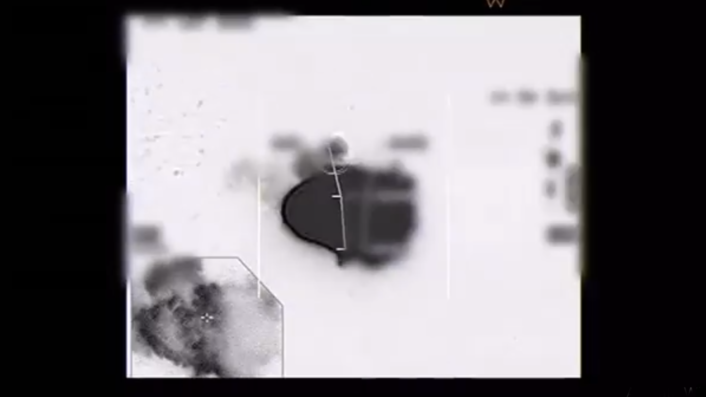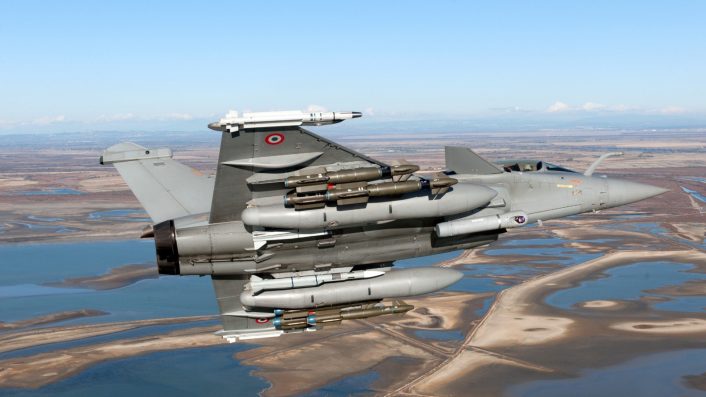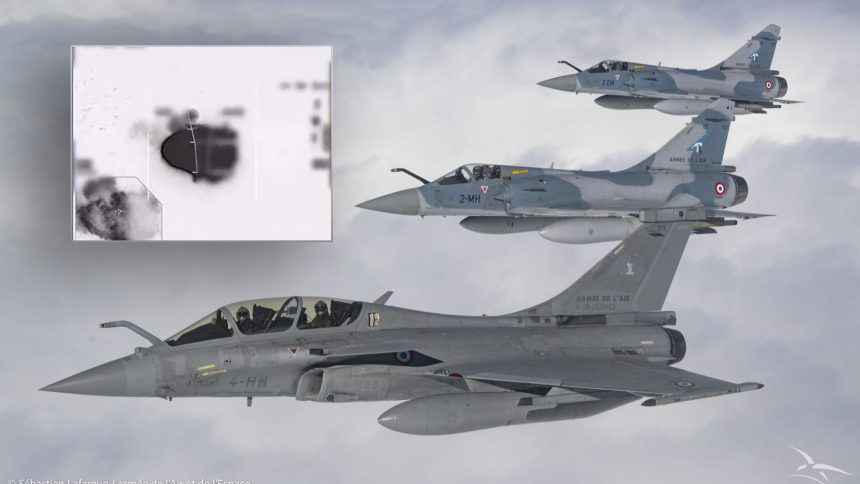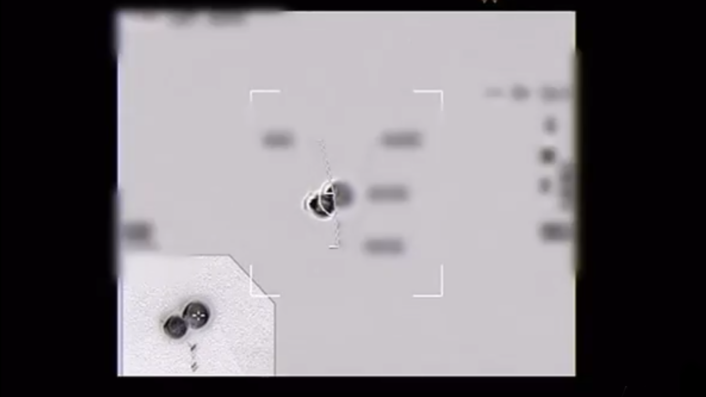French officials expressed concern over high-altitude objects beyond 20 km, an area which is becoming increasingly contested.
France announced on Jun. 24, 2025 that it has tested the engagement of “stratospheric balloons operating at very high altitude,” shooting them down with MICA air-to-air missiles launched by Mirage 2000 and Rafale fighters. The balloons, provided by CNES (Centre National d’Études Spatiales/National Center for Space Studies), were flying at an altitude of over 20 km (65,000 ft).
Defense Minister Sébastien Lecornu said on X that the “test launches pushed the technological constraints imposed on the aircraft, its pilot, and its weaponry beyond 20 kilometers of altitude.” Additionally, he added “this marks the first milestone in the interception component of our armed forces’ strategy for very high altitude, which is becoming a contested space.”
The one-minute video shared by Lecornu showed footage from inside the cockpit of a French Air and Space Force (FASF) Rafale, possibly captured by an action camera mounted on the pilot’s helmet during the engagement. Infrared footage captured by an electro optical system shows the missiles striking the balloons.
French military officials expressed concern over high-altitude objects and balloons since a series of Unidentified Aerial Phenomena (UAP) were shot down over Canada and the United States in 2023. Between Feb. 10 and 12 of that year, one object was shot down over Alaska, the other over Yukon, and the third over Lake Huron. The shoot-down of a Chinese high-altitude balloon over South Carolina on Feb. 4, 2023, particularly spurred the effort, before the FASF announced the future capability demonstration that took place now.
🇫🇷French Rafale and Mirage 2000 fighter pilots recently practiced destroying several stratospheric balloons at very high altitude using MICA air-to-air missiles, following the “🇨🇳2023 Chinese balloon incident” over the 🇺🇸USA that got destroyed by a F-22 using an AIM-9X missile. https://t.co/RekWx03R02 pic.twitter.com/KaI48QKbXg
— Etienne Marcuz (@Etienne_Marcuz) June 23, 2025
Shooting down balloons with AAMs
It is not clear how many Mirage 2000s and Rafales were used in the test, or whether other surveillance aircraft with EO/IR systems may have been used. It is also possible the footage is from the IRST (Infra-Red Search and Track) systems of the Rafale fighters.
The MICA medium-range AAMs have two main variants – the IR-seeker MICA IR and a radar-homing MICA RF. It is not clear which of the two was used to shoot down the balloons in the latest test.
Given the absence of radio frequency emissions from such balloons, the MICA IR, that locks on to heat signatures, may have been used. However, considering the plural in Lecornu’s statement hinted that there were at least two test shootings, the Mirage 2000 and the Rafale might have fired both the MICA RF and the MICA IR variants.
France also recently tested the new MICA NG, which comes in an Imaging Infrared (IIR) and an Active Electronically Scanned Array Seeker (AESA) seeker variants. The new weapon is said to surpass the “latest generation” of AAMs, while the IR variant is said to offer “all-weather shoot-up/shoot-down capability.”
Generally, while the capability to shoot down slow-moving, high-altitude objects is not impossible, as was seen in the incidents over North America in Feb. 2023, it might present some challenges, with an example being the reduced IR signaturer. The timely detection of these objects before they stray into sovereign airspace is vital.

Therefore, the FASF may have also frozen surveillance and tracking protocols of such objects by mobilizing both their air and space assets. The balloon’s lack of a metallic body and atypical floating movement often go undetected by radars meant for fast flying, large aircraft and missiles. Optical reconnaissance is often more effective in these cases.
The statement’s did not indicate whether France’s E-3F Sentry AWACS (Airborne Warning Control System) were employed and if they experienced difficulties in tracking the very high-altitude objects.
C’est l’heure du #FighterFriday avec les Mirage 2000 déployés en Lituanie dans le cadre de leur mission de Police du ciel #vendredichasseur pic.twitter.com/hAHCX1PEwH
— Armée de l’Air et de l’Espace (@Armee_de_lair) October 7, 2016
High-altitude threats
OPEXNEWS said the FASF has identified two types of targets that would constitute future threats at these altitudes. In the first category are “High-Altitude Pseudo Satellites (HAPS)/stratospheric balloons” and drones that can stay airborne from several days to several weeks gathering intelligence. The others are hypersonic missiles and “maneuvering gliders” (Hypersonic Glide Vehicles) that exploit the “less dense layers of the atmosphere to extend their range and bypass defenses.”
The shooting demonstration also tackles the undefined jurisdictional issues in “near space” between 20 to 100 km above sea level that faced Western militaries after the Chinese balloon incident, according to a Jan. 2025 interview of Gen. Alexis Rougier in Paris Match, who was appointed to head the FASF’s very high altitude office the previous year. Existing international laws and treaties are still ambiguous on whether it is to be considered sovereign or international airspace.
Most recent image of the Chinese balloon obtained in Candler, NC
Author: Blake Cloningerhttps://t.co/dpWkaBYVMp pic.twitter.com/EEj50pO3ga
— StratoCat (@stratoballoon) February 4, 2023
The downing of the Chinese balloon on Feb. 4, 2023 over South Carolina saw an F-22 from the 1st Fighter Wing (1st FW) of Langley AFB, Virginia, firing an AIM-9X. The Raptor was flying at 58,000 feet, while the balloon was between 60,000 and 65,000 feet. The Chinese side alsd acknowledged the balloon’s origin, but maintained it was a weather research object, denying any military use.
Photos show the Chinese Balloon being shot down by a F-22 Raptor from Myrtle Beach, SC!
📸Me pic.twitter.com/AWSmILlRzg
— Jake Bradshaw (@jake_b_photo) February 4, 2023
‘France needs to display its capability’
Rougier further told Paris Match that that the FASF’s Rafales, Mirage 2000s, and “ground-to-air systems” do offer “interception capabilities,” but they still need to demonstrate “these capabilities aimed at detecting” and “neutralizing” threats, while also themselves “taking advantage” at “very high-altitudes […] from 2025.”
In Oct. 2024, the FASF’s Chief of Staff General Jérôme Bellanger told lawmakers of the National Defense and Armed Forces Committee the importance of controlling the “virgin zone” between 20 to 100 km, where the Chinese balloon was flying. “Investment is absolutely essential in this area. On the one hand, it is dual-purpose. It will enable the deployment of resilient communications, internet connectivity, and surveillance systems for both civilian and military purposes. On the other hand, nature abhors a vacuum; if we don’t go there, others will. There is no question of letting Chinese balloons position themselves above our heads and observe us. We will therefore have to develop neutralization methods capable of reaching the THA,” he said.

The latest test is also consistent with Paris’ proactive role in European security and NATO. This was reflected in the Pégase 25 deployment to Sweden in April and President Emmanuel Macron announcing on Mar. 18, 2025, the reopening of Luxeuil Air Base (Base Aérienne 116). This was to begin operating the newest Rafale F5 variant, which meets the nuclear deterrent role with the hypersonic ASN4G nuclear cruise missile.
TAGS: French Air and Space Force, Armée de l’Air et de l’Espace, High-altitude balloon, Chinese spy balloon, Dassault Rafale, Mirage 2000, MICA, Directorate General of Armaments, CNES, Centre National d’Études Spatiales










